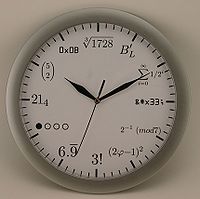Course:MATH103/Archive/2010-2011/207/Lectures/Lecture12
| Faculty of Science Department of Mathematics | |
|---|---|

| |
| Course Pages | |
| Course Policies | |
| Math Solvers | |
| Exams | |
| Quizzes | |
| Assignments | |
| Lectures | |
Lecture 12
Readings For This Lecture
- Chapter 6, pages 118 to 132
Summary
Group 6: Add a summary of the lecture in this space. Include examples, discussion, and links to external sources, if desired.
Exercises
1. Compute the integral
by using the substitution .
| [show]Solution |
|---|
2. Compute the integral
by using the trigonometric identity . Verify that you get the same answer as in question 1.
3. Compute the integral
using the substitution . Use a geometric argument to verify your solution.
4. Compute the integral
.
5. Compute the integral
.
6. Use integration by parts to show that
.
Shouldn't the answer be? Am I missing something here?
. (correct! CameronChristou 14:19, 10 March 2011 (PST))
7. Make a substitution, and then use integration by parts to evaluate the integral
.
8. Find the center of mass of a distribution .
This is a bit strange... would the answer be that it does not exist? Because the total mass, and the center of mass equation would then be which would be impossible.
(Good catch. The problem as stated doesn't make sense. First of all, the distribution will have negative values inside the interval of definition. Distributions (or densities) can't be negative. This is the reason for the eventual division by zero. For practice, try this question when is only defined for CameronChristou 12:15, 12 April 2011 (PDT))
9. Find the volume of a solid torus (donut shaped region) with radii and as shown in the figure below. (Hint: There are several ways to do this. You can consider this as a surface of revolution and slice it up into little disks with holes (“washers”) as shown.)
10. Let the density of mass along a bar of length be given by . Find the total mass of the bar. Find the average mass density along the bar. Find the center of mass of the bar.


















